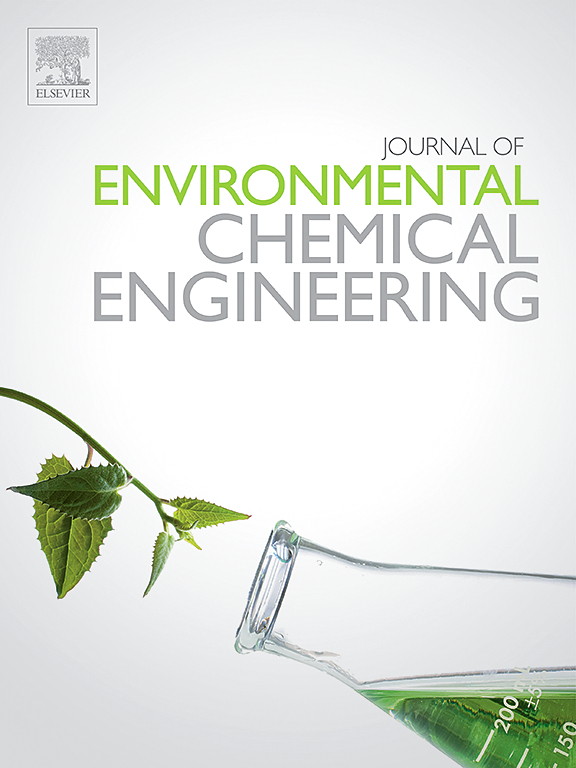Enhanced phenol degradation in wastewater using non-thermal plasma coupled with NiO/g-C3N4 nanocomposite catalyst
IF 7.4
2区 工程技术
Q1 ENGINEERING, CHEMICAL
引用次数: 0
Abstract
In this study, NiO/g-C3N4 nanocomposites with varying amounts of NiO were successfully synthesized via the hydrothermal method and demonstrated significant potential for plasma-catalytic phenol degradation. The formation of a p-n heterojunction at the interface between NiO and g-C3N4 facilitated enhanced charge separation and transfer under the influence of an internal electric field, effectively suppressing charge recombination. Comprehensive characterizations were conducted to examine the structural, morphological, optical, and textural properties of the catalysts. Density functional theory (DFT) calculations were also employed to elucidate the interface interactions and the mechanism behind the enhanced plasma-catalytic performance. The active species participated in the removal process were identified through quenching experiments and in situ optical emission spectroscopy (OES). The 20 % NiO/g-C3N4 composite exhibited the highest phenol degradation performance, achieving 97 % phenol decomposition, compared to 71 % and 62 % for pure g-C3N4 and NiO, respectively, under optimized reaction conditions, which included a power of 10 W, an initial phenol concentration of 100 ppm, a catalyst amount of 2 g/L, and an initial solution pH of 7. In addition, the 20 % NiO/g-C3N4 composite exhibited excellent recyclability and cyclic stability, with only a minor decrease (7 % decline in degradation efficiency) over five consecutive cycles. Finally, a possible phenol degradation pathway was proposed based on the identified intermediates. This work provides valuable insights into the design of advanced p-n heterojunction catalysts with exceptional UV-Vis and plasma responsiveness, offering a promising approach for improving wastewater treatment and addressing environmental challenges.
非热等离子体耦合NiO/g-C3N4纳米复合催化剂对废水中苯酚的降解
在本研究中,通过水热法成功合成了不同NiO含量的NiO/g-C3N4纳米复合材料,并证明了其在等离子体催化降解苯酚方面的巨大潜力。在NiO和g-C3N4的界面处形成p-n异质结,在内部电场的影响下,促进了电荷的分离和转移,有效地抑制了电荷的复合。对催化剂进行了结构、形态、光学和织构等方面的综合表征。密度泛函理论(DFT)计算也用于阐明界面相互作用和背后的等离子体催化性能增强的机制。通过淬火实验和原位发射光谱(OES)鉴定了参与去除过程的活性物质。在功率为10 W、苯酚初始浓度为100 ppm、催化剂用量为2 g/L、初始溶液pH为7的优化条件下,20 % NiO/g- c3n4复合材料的苯酚降解率最高,达到97 %,而纯g- c3n4和纯NiO的苯酚分解率分别为71 %和62 %。此外,20 % NiO/g-C3N4复合材料表现出优异的可回收性和循环稳定性,在连续5个循环中,降解效率仅略有下降(7 %)。最后,基于所鉴定的中间体,提出了可能的苯酚降解途径。这项工作为设计具有优异UV-Vis和等离子体响应性的先进p-n异质结催化剂提供了有价值的见解,为改善废水处理和应对环境挑战提供了有前途的方法。
本文章由计算机程序翻译,如有差异,请以英文原文为准。
求助全文
约1分钟内获得全文
求助全文
来源期刊

Journal of Environmental Chemical Engineering
Environmental Science-Pollution
CiteScore
11.40
自引率
6.50%
发文量
2017
审稿时长
27 days
期刊介绍:
The Journal of Environmental Chemical Engineering (JECE) serves as a platform for the dissemination of original and innovative research focusing on the advancement of environmentally-friendly, sustainable technologies. JECE emphasizes the transition towards a carbon-neutral circular economy and a self-sufficient bio-based economy. Topics covered include soil, water, wastewater, and air decontamination; pollution monitoring, prevention, and control; advanced analytics, sensors, impact and risk assessment methodologies in environmental chemical engineering; resource recovery (water, nutrients, materials, energy); industrial ecology; valorization of waste streams; waste management (including e-waste); climate-water-energy-food nexus; novel materials for environmental, chemical, and energy applications; sustainability and environmental safety; water digitalization, water data science, and machine learning; process integration and intensification; recent developments in green chemistry for synthesis, catalysis, and energy; and original research on contaminants of emerging concern, persistent chemicals, and priority substances, including microplastics, nanoplastics, nanomaterials, micropollutants, antimicrobial resistance genes, and emerging pathogens (viruses, bacteria, parasites) of environmental significance.
 求助内容:
求助内容: 应助结果提醒方式:
应助结果提醒方式:


